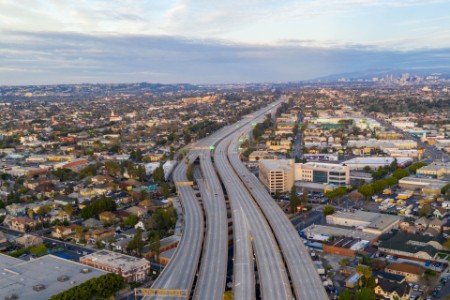
Chapter 1
The big slowdown
Our findings suggest that there has been a major slowdown in consumer mobility around the globe.
As lives have become centered on the neighborhoods where people live rather than where they used to go to work, travel has become less frequent, more local and increasingly domestic, focused on household essentials rather than work or fun. With millions now freed from the daily compulsion to get to and from their place of employment, travel for work has seen the largest overall drop in journey numbers. It’s down by 61% — a consequence of the rise in the number who report working from home at least 60% of the time, up 4.5 times from 16% to 73%. Leisure and entertainment journeys are also down — by 51% — suggesting that when consumers have a choice not to travel, they are increasingly taking it.
A shift to prioritizing essential journeys is also reflected by trips for household and social purposes showing the smallest decline at 40%. Journeys to meet friends and family fell the most — by 50% — while journeys for unavoidable necessities, such as shopping for household essentials and doing the laundry fell least, by 21%.
This picture of less mobility overall and altered priorities for remaining travel is borne out by travel time figures. The average weekly travel time per person is down 40%, from 6 hours to 3.7 hours. Within that, the proportion of time spent on shorter journeys of less than 30 minutes has increased substantially in 2 of the 3 segments — up 79% for leisure and entertainment travel and 57% for household and social. Even assuming some level of digital substitution — meals delivered rather than eaten in a restaurant, for example — points to economically damaging reductions in discretionary expenditure. These are likely to hit city centers hardest as consumers spend much more of their time close to where they live rather than to where their employer is located.
In short, people are thinking much harder about journeys they would have taken without a moment’s consideration pre-COVID-19. Conscious consumption — traditionally associated with food and consumer goods — may now be moving into the mobility arena, presenting both a huge short-term challenge to existing transport networks and plans, but also a tremendous opportunity to reimagine and re-invent local environments and economies over a longer time scale.

Chapter 2
The car makes a comeback
For the time being, consumers are increasingly choosing to travel by personal cars.
Where journeys are still being taken, consumers are eschewing those modes that require them to share space with strangers in preference for solo modes, or at least sharing only with family members. Rides by taxi and public transport saw the biggest drops by segment across the board, while journeys made by personal vehicles (car or motorbike) and micromobility journeys (bikes, e-bikes and scooters) were least impacted.
Consumers are redefining safety. Historically all about avoiding accidents and injuries on the road, safety has become a much broader and more influential category also embracing hygiene, cleanliness and well-being. These factors are now pivotal in consumers’ choice of transport mode, with cars offering the safest way during COVID-19 of moving around for many people. In line with this focus on safety, the usage of cabs and public transport declined most among gen X’ers and baby boomers, the age groups known to be at highest risk from COVID-19.
One big question is whether these changes will be permanent or temporary. Rising delays and congestion on the roads may encourage some to return to public transport in search of shorter journey times. Public transport operators are also working hard to persuade consumers that measures such as mask-wearing and enhanced deep cleaning of vehicles are effective in lowering risk. But it is hard to imagine a return to previous levels of ridership, at least until COVID-19 is under much more effective control. A long-term shift in favor of the private car would have major consequences for transport planners and city authorities where efforts to reduce congestion and pollution have so far been focused largely on persuading people out of their cars and onto public transport instead.

Chapter 3
Culture vs. compulsion
The global big picture of restricted mobility misses details of national and regional differences.
Some of these details can be accounted for by variations in the severity of lockdown measures applied by government, while some are more likely social and cultural in origin. People in Sweden, for example, where few significant restrictions beyond social distancing were imposed, do seem to have maintained a more “normal” social life, at least judging by their mobility patterns.
Surprisingly, Sweden also posted the biggest drop in work travel, 70%, prompted by the largest reported rise in people working remotely or from home at least 60% of the time, up 72%. The smallest increases in remote work were posted in the UK and the US, at 47% each. So, more Swedes than Brits or Americans chose to work remotely, even though they were not compelled to do so, perhaps reflecting a greater level of trust in decisions made by central government.

Chapter 4
The death of the commute?
The rising number of people working from home has resulted in major declines in commuting times.
Overall, the proportion working exclusively at home has increased ninefold, from 4% to 35%, and the average number of work journeys per month has dropped 61%.
As expected, those living in major metropolitan areas experienced the biggest decline. People spending more than 5 hours a week commuting fell from 60% to 29%, compared with those in small town or rural areas where the drop was from 47% to 22%.
Given the relative success of working from home during the pandemic and the known impact of long commutes on well-being and happiness, it will be interesting to see how this trend develops. A long-term decline in commuting time could mean a lower peak demand and less strain on public transport systems and road networks. It could also mean greater individual autonomy over working hours and the freedom to travel more often for non-work reasons. But it would also present an ongoing challenge to the revenues of train, bus and subway operators, whose operational costs have already risen due to COVID-19 control measures they have had to take.

Chapter 5
Sustainability still a struggle
The drop in pollution in cities was one of a few positive side effects of the pandemic’s early days.
Emissions fell dramatically, skies cleared and the residents of New York, London, Shanghai, Mumbai and other major — and usually traffic-clogged — global cities enjoyed clean air for the first time in decades.
EY analysis shows that monthly per capita emissions of carbon dioxide (CO2) fell globally across all three travel segments, broadly tracking the decline in journey numbers already noted. Emissions fell substantially, by 56% for work travel, 58% for social and household travel, and 62% for leisure and entertainment.
Permanently capturing these early gains is going to be a challenge, partly because emissions rise and fall in step with economic activity, which has been severely reduced by the pandemic, and partly because consumer behavior on sustainability remains contradictory. The emissions due to private cars only fell by 51%, less than for any other major mode of transport except for ferries. The share of total emissions due to cars has actually risen, up to 65% now from 59% pre-COVID-19.
Where convenience and speed once won out over eco-concerns, now the prospect of catching COVID-19 seems to be pushing climate concerns to one side in the minds of consumers. With traffic levels already rising again, governments and transport authorities are faced with a trend that could undo decades of steady progress on sustainable mobility, leading to gridlocked streets, failing public transport networks and even worse emissions.
Reflecting the rise in local activism fueled by more people spending more time at home, cities and local neighborhoods are taking it upon themselves to try to shape an alternate and more palatable version of the future. Several London boroughs have begun to roll out “Low Traffic Neighborhoods,” whereby residential streets frequently used as shortcuts by through traffic have been restricted to pedestrians and bicycles only. In Paris, 650 km of emergency cycle lanes created during the pandemic will be permanently added to the city’s transport network. And Copenhagen is planning an entire low-carbon economy based on biomass, wind and geothermal power. The intention is to be zero carbon by 2025 and to create 35,000 new jobs in the process.
Due to the preference for private transport, efforts to speed the replacement of internal combustion engine (ICE) personal vehicles with more sustainable alternatives are being scaled up. Larger incentives to purchase electric vehicles (EVs) already form part of the EU COVID-19 recovery package in France, Germany, Spain, Italy and Austria, reducing transport-related emissions while also boosting jobs and the industrial economy.
The nascent micromobility sector may also become more widely embraced by city authorities. Quick and cheap to roll out, requiring minimal infrastructure and highly sustainable, hired e-scooters could rapidly become a viable and low-infection risk option for shorter journeys that would otherwise be made by car or public transport.

Chapter 6
The conflicted consumer
We have already seen disruptive change in the established patterns of mobility around the globe.
Although it has only been nine months since the global pandemic was declared, we have already seen disruptive change in the established patterns of mobility around the globe, raising equally substantial questions about the nature and shape of our cities and transport networks. Some of these changes have a “be careful what you wish for” quality — a year ago many city planners and government transport ministers could only dream of the drops in total transport-related CO2 that have since been recorded. But the way in which this has happened is surely nightmarish.
External events will continue to have major and unpredictable impacts as lockdown restrictions come and go, and as local responses vary.
Meanwhile, the consumer is conflicted over mobility. Not having to commute to work has given many work-from-homers a new sense of autonomy as well as a couple of hours of their time back every day. But while COVID-19 remains barely controlled in many geographies, entertainment and leisure activities that used to be taken for granted are also severely curtailed. Shopping is largely restricted to essentials. And while many city dwellers would like to see the clean air and quiet streets of lockdown become a more permanent feature of their environment, their immediate preference for pandemic-safe car transport seems to be winning out over longer-term worries around sustainability.
Which, if any, of these conflicting narratives will translate into permanent changes? Will the opportunity for a “reset” based on family and the local community overcome the desire for a return to “normal” life? How will concerns over infection risk and the economy be reconciled with the pressing need for a more sustainable tomorrow? And what will the consequences be for the way we think about mobility?
It’s still too early to fully answer these questions, but here are a few key behavioral takeaways from our first EY Mobility Consumer Index research:
- Personal safety is paramount. Reducing the risk of infection is now the most influential factor in travel decision-making.
- Work is what you do, not where you are. With millions working successfully from home, travel for work has become largely discretionary.
- Consumer are more conscious of their mobility consumption. People are taking fewer journeys and assessing the risk/benefit of those they do take much more carefully.
- Less is more. Shorter journeys are on the rise, as consumers spend more time closer to home, and become more engaged in their local communities.
- There’s a public transport triple whammy; operators must overcome a trio of challenges including shrinking revenues, rising operational costs and an uphill battle to persuade consumers that it’s safe to ride their networks.
- Sustainability can’t be left to consumer choice. The spirit is willing, but the flesh is weak.
Summary
The pandemic has drastically changed consumers’ mobility habits. Whether those changes are here to stay is up for debate. While it’s too soon to tell, some takeaways from our Mobility Consumer Index research that come into play with mobility decisions for consumers are personal safety, work travel, destination selections, the safety of public transport and sustainability.


